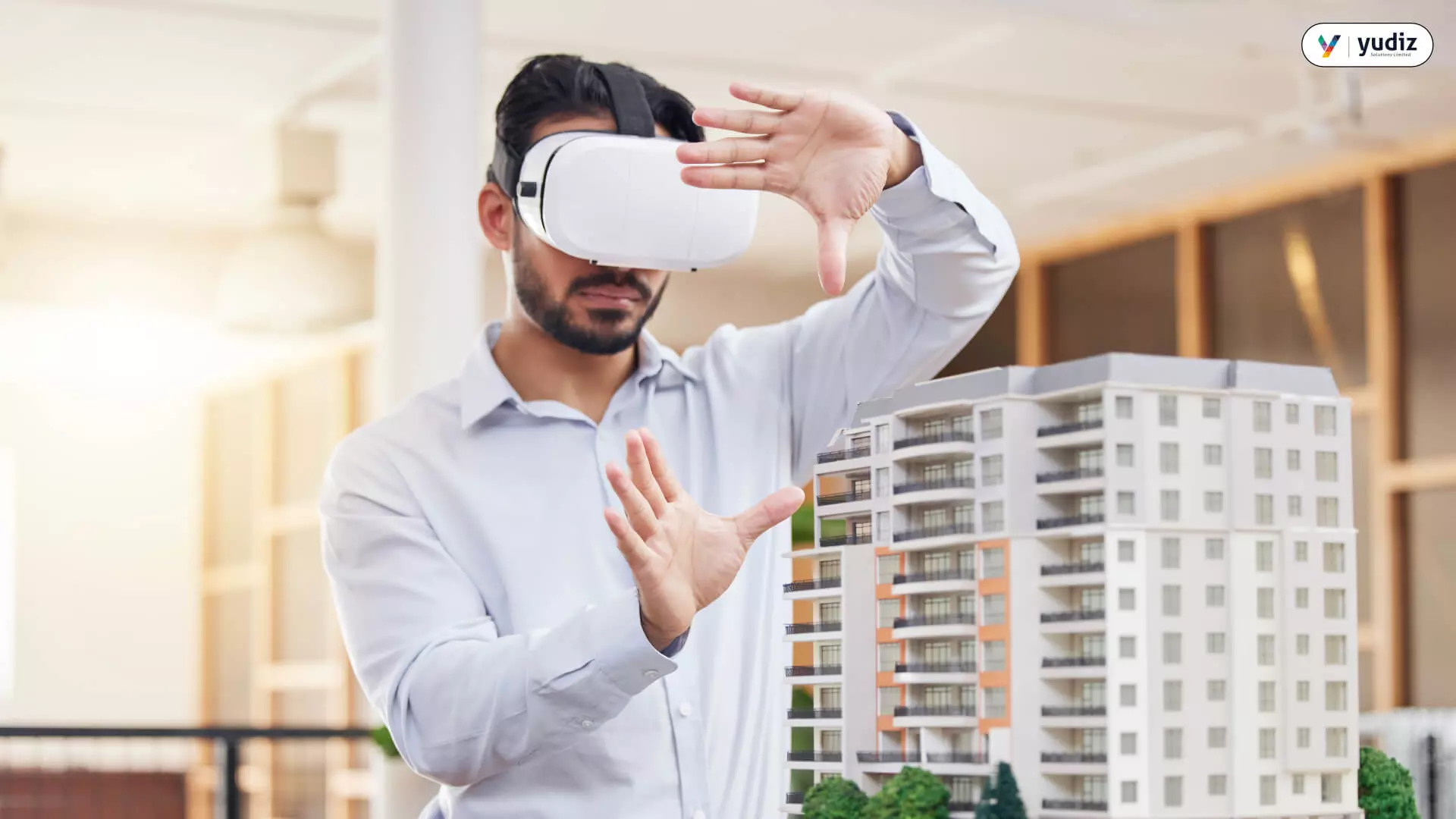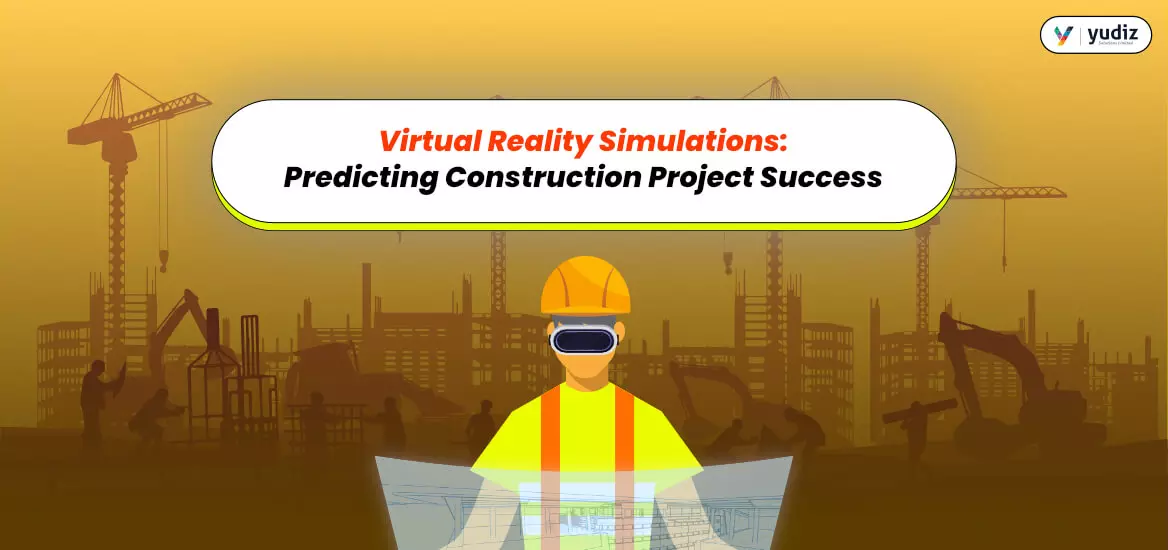Innovation12th July 2024
Did you also think that VR was just for games and fun? Then, let us break it to you, you are highly mistaken. Virtual Reality has far more leverage, use cases, and dynamicity for multiple industries. And, Virtual reality in Construction and real estate is one of them. Yes, you might think this isn’t the absolute truth. But, it is! Also, the construction industry has always been a little slow in adapting to new technologies. However, this time around with virtual reality adaption, the tables have turned. There is a dawn of new advancement for the Architect, Engineer, and Construction (AEC) industry and with that the customers and clients.
Right from bringing them to stand virtually in their (future) hall rooms and balconies. To place a risk-free virtual site for the workers to practice operating machinery etc. So, this means VR Simulations are a big chunk of takeaways on all fronts. Because on one side you are offering futuristic and next-gen services to your clients. And, on the other end, you are providing risk-free safe working protocols for your team. With that, saving costs and improving efficiency. To know more about virtual reality in construction, skim through the blog.
What are Virtual Reality Simulations?
To know about virtual reality simulations and virtual reality in construction. You first need to understand the concept of Virtual Reality. So, virtual reality is all about creating a space with computers and technology. A realistic space is created to teleport the users into a world of reality that is made up and created into an imaginary space. However, there is a specific VR gear that helps one to tap into the VR space. So, like you out on those glasses and voila you have entered into that VR space or a fantasy land immediately. VR in construction industry is advancing your offerings while saving.
So, now that you know about virtual reality, at the core. Let’s understand what are VR simulations. These allow the users to interact with the virtual objects as if they are real. In short, these VR simulations ensure that the users have a seamless experience in the VR space. Well, in the context of the construction and real estate industry, this means virtual site visits, safety training, etc.
Well, in simple terms VR simulations blend virtual reality with the real world. It bridges the gap and allows users to interact with the objects in the VR space. Now, that we have decided what VR and VR simulation means. Let’s quickly see how these simulations specifically work for Virtual Reality in construction.
How do VR Simulations Work?
They work in more ways than one. That’s for sure. But, how these VR simulations work for the construction industry is the real deal.
At the core how they work is pretty simple. The user puts the VR gear, i.e. the VR headsets and stuff. Further, this helps them to dive into the 3D computer-generated environment. Although, that’s there interaction and navigation reigns supreme here in the VR space. The more seamless it is the better it is. Say for example you have a site in progress. So here the VR simulations for construction will come to show in blending, bridging, and seizing the gap between real and virtual. This means here, every aspect, the aspects, the dimensions in the virtual space.

In short, VR simulations in the construction industry does is it make the navigation as good as your user was present in a physical space. The ultimate test here for the VR simulations is this. If it gives the user the same impression as if they were present in the physical space. This is how advanced virtual reality in construction is.
Look, now you know the purpose and role of VR simulations for the construction industry. Now, is the right time to know how these VR simulations come to show. Particularly, we are now going to skim through the section that will let you know how is VR in construction.
How Can VR Simulations Be Helpful for Construction Projects?
VR in construction industry is a big boon. So, to say it comes to show in more ways than one. Construction and real estate as an industry is a futuristic move. And, the thing is if you are into this industry, pick this technology and put the chips here. Because via this one technological facelift, there are multiple takeaways that you get. But, let us first discuss how is it supremely helpful.
It is a fact that construction as an industry has been a little reluctant to adopt new technologies. But, the risk, uncertainty, and need are quite massive on this front. Nevertheless, VR technology in construction industry has a way to even this out. Know how.
Designing and modeling are innate characteristics of the construction industry. And, as we mentioned earlier if you ever thought VR is just good and useful for games. Then you’re wrong. Because Virtual reality in construction is nothing short of a knight in shining armor. Because with this you can bid adieu to the design glitches and those disorganized 2D design layouts.
The way it helps: Immersive exploration of designs which further leads to informed decisions. And, decision paralysis is the fastest way to book a loss yeah? Here, custom VR development services would be beneficial.
The modern consumer base is not very welcoming of vanilla services. Imagine rolling out that design map and manually explaining to your client the entire space. (Yes, like the architects in the old times did). Well, it is a big no. These days, VR construction services taking center stage. The least your client would expect is a ‘VR-infused site walkthrough’. Yes, that’s the bare minimum, considering the entire frenzy of virtual reality in construction.
This is where the VR comes to show. Improved collaboration and real-time virtual site visits help your clients to have a 360 immersive visit and walkthrough. Also, this avoids the chances of design flaws and helps with amassing client satisfaction.
Risks and safety hazards at the construction sites predominantly exist. But, with VR training and simulations there is a way out you get to dodge the risks on site. Now, what these do is provide a virtual space for your site. So, the training, navigation of the site, practice, and training sessions on how to operate those equipment work, etc.
VR in construction training: Yes, that’s the help. Enhancing productivity and increasing the safety protocols on site are equally important.
Besides this, there are other fronts where Virtual Reality in construction comes to show. Like to claim what we said. There are cost and time-savvy offerings at the forefront of VR in real estate. Plus there is accelerated client engagement, efficient decision-making, interactive VR immersion of the property, etc.
Benefits of VR Simulations in Construction Projects
The construction industry or real estate for that matter would have not been receptive to newer and futuristic technologies. But, when it comes down to perks and leverages, there for sure are a ton to list on the stage of Virtual reality in construction.

Skim through to take note of the benefits that VR simulations for construction have.
- Accelerated Client Satisfaction
- Advanced Safety Protocols
- Modern & Safe Training Sessions
- Immersive Site Walkthroughs
- Hyper-Immersive Design Exploration
- Cost-savvy yet Modern Offerings
- Massive Client Satisfaction
- Global Collaboration via Virtual Reality in Construction
- Customized Services
This was a sneak peek into the benefits of integrating Virtual reality in construction. Whereas, it is equally important to look into the fact as to why investing in this genre is a lucrative move for the future.
How Much Does it Cost to Develop VR Simulations for Construction?
Getting simulations for VR in construction training is a no-brainer, these days considering the benefits, surge, and adaption. But, decoding the cost of these VR simulations is again an aspect that can not be missed. Also, the noon-negotiable here is you will need to get in touch with a Top VR app development company. Because expert VR developers, project managers, and an entire team will be required to help you get the best product developed.
Coming to the development cost. We shall give you factors that will impact the development cost. However, this is not the final count of aspects, there can be changes and alterations considering the business/project requirements.
Factors that Impact/Influence the Costs of VR in Construction:
- Modeling & Simulation Requirements
- Interface Chosen
- Level of Immersion
- Personalization VR Construction Services Requests if Any
- BIM Data Integration
- UI/UX Design
- User Support Features
- Hardware Requirements if Any
Besides this, the top VR app development company that you choose will also to some extent impact the cost. But, it also comes with perks, proficiency, and expertise which will ensure you get to offer advanced services.
Why Should You Invest in VR Training & Simulations?
It is pretty obvious that if you are into real estate or construction business. Considering these modern-day site requirements of the staff and also the client requirements. Plus, when it comes to Virtual Reality in construction there is a suite of perks to bank on. And, the most important and biggest win and perk is that it turns out to be cost-savvy. Yes, so you save bucks post integrating or adapting VR in the construction Industry.
See, have you ever heard the phrase, ‘One-time investment’? VR for real estate is exactly like that, more so in the sense that you get to bank on a plethora of takeaways. The biggest however is accurate decision-making- which leads to fewer glitches in the future. Now, this is just one big reason, there are many like that. Skim through the points below to know what should you invest in Virtual Reality in construction.
1st Reason: Time and money are the most crucial aspects of the real estate industry. Do you want to save time and money while winning big? With, VR training and simulations you will save time and money on a massive base. Because you get to skip all those time-consuming training sessions. Adding to that, these virtual training sessions will also help in dodging accidents and save costs there. Plus, with that, accurate resource allocations and time efficiency will add up to timely services.
2nd Reason: This is the ‘Triple C Rule’. By this what we mean is for every business Client, Collaboration and Communication are of utmost importance. And, the same goes for the construction industry. And, guess what Virtual reality in construction is here to solve all your cold start problems to the major ones. Virtual walk-throughs and immersive collaborative discussions on the designs and models via VR simulations for construction will help with all that and more. On top of that the cherry on the cake is this collectively leads to better decision-making, cost-savvy moves, and having a competitive edge.
3rd Reason: Tapping into trends and offering services that are not just trending but effective, cost-savvy, and lucrative is not a bad move yeah? And, when it comes to Virtual reality in Construction you for sure know by now that it is super beneficial, right? Over and above that, by integrating VR into your construction business you will reign supreme and ‘Be at the forefront of the Technological Facelifts.’ Again, this factor adds up to your business offerings in the market. Besides that, you will need to hire VR construction services.
Also, one of the reasons here is to stay relevant and more so lead in the genre. So, at times if your competitors are integrating such technologies like virtual reality in construction. You got to do it too. Because in toto, having a competitive edge and having a decent business reputation is something that you cannot take a raincheck on.
While that’s there, let’s decode the most important aspect. The cost of developing the VR simulations for construction.
Will VR Technology in the Construction Industry Be Beneficial in the Future?
When it comes to VR technology in the construction industry it is for sure here to say. This might come across as a big statement for some. But, if we take a look into how big of a pool of benefits it has. There is a ray of hope that signals a shining future.
On the other, hand some reports and data also support the prediction of the success of the construction industry. Where the global VR market size is to go beyond 22 billion USD by 2025. This here of course signals a potential and path to put to chips on virtual reality in construction as an industry.
Read: The Future of Slot Game Development: Predictions and Innovations
Shape the Future with AR/VR!

Final Thoughts !
It’s the right time to go from merely a construction company to a VR construction company. Because in total virtual reality is loaded with perks and takeaways on more fronts than one. Virtual reality in construction is certainly something to be bullish on to eventually win over the clients, and have a safe-secured working space for your team. And, more importantly, have saved costs and have a competitive upper hand in the market. Plus, it is no longer the case that the construction industry is reluctant to adopt technologies. So, for the years to come almost every company (including your competitors) will put their chips on Virtual reality in construction. So, gear up to get ahead of the race and claim your takeaways now.
Frequently Asked Questions
When it comes to virtual reality in construction industry there are multiple use cases and leverages. It is not just one front that it serves or helps with. There are many takeaways. Like VR-infused virtual walkthroughs, immersive collaborations, virtually extensive design visualizations something that goes beyond 2D/3D and provides realistic views. With that, there is VR training and simulations and virtual reality infused machinery operating sessions to ensure safety training etc.
There are not one or a few but there is an entire suite of benefits that virtual reality in construction entails. Right from cost efficiency, time efficiency, risk-free training set-ups, project visualization, lesser design glitches etc. Then there are also long-term benefits like client satisfaction, safe working space, advanced offerings and decent market reputation.
Safety training is one of the biggest perks and advantages when on the bedrock of virtual reality in construction. This is also because the construction industry inherently is accustomed to risk and hazards. But, with VR technology in construction industry, it helps to reduce accidents by giving a virtual space to practice operating machinery etc. With that it allows the users to have a risk-free environment to get well-versed with the work attributes.
Yes, cost and time are some of the most advantageous takeaways when it comes to virtual reality in construction. Now, this is how it comes to show. It allows the users to dodge decision paralysis, have an immersive analysis of design, and flag and dodge flaws if any at an early stage. This further helps in efficient and accurate decision-making. Further which results in cost efficiency.
Virtual reality in construction is a big move because it allows the investors and clients to have a 360 view, immersive analysis, and in-detail analysis. This further results in client satisfaction via informed decision-making. And, the ultimate result is it helps in predicting the future outcomes and success of a construction project. So, opting for custom VR development services here is a great move ahead.





















